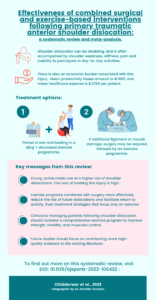This blog explains the effectiveness of exercises for first-time shoulder dislocations that occur in the forward direction due to a direct blow to the shoulder [primary traumatic anterior shoulder dislocation]. As an author group, we spent the last 3 years working through existing research to compile it into what is one of the highest levels of scientific information [systematic review and meta-analysis]. We have combined this research into a paper which is summarised in this blog (1).
Why is this study important?
Shoulder dislocation can be disabling, and is often accompanied by shoulder weakness, stiffness, pain, and inability to participate in day-to-day activities and sport. More men tend to participate in contact sports and physically challenging occupations, compared to women – putting them at a higher risk of shoulder dislocation (2). Additionally, following an initial shoulder dislocation there is considerable risk of another dislocation within 6 months [i.e. recurrence]. Individuals who have dislocated a shoulder often have difficulty returning to occupational or athletic activities. There is also an economic burden associated with this injury. For example, mean productivity losses amount to €1469, and mean healthcare expense is €3759 per patient (per dislocation) without surgery. Surgery expenses further add to this cost burden (3).
Current shoulder dislocation management comprises a period of rest and healing in a sling [immobilization], followed by a structured exercise program. If the dislocation has caused additional damage to surrounding muscles and/or ligaments then surgery is often required, followed by an exercise program. Exercises are a crucial part of shoulder dislocation management protocols, prompting a need to document their effect on dislocation recurrence and return to activity after a first-time shoulder dislocation.
How did the study go about this?
We searched online research databases for papers that used any form of exercise-based treatment for first-time shoulder dislocations, and found over 3600 related study titles. For our review 60 of these studies (N=3600) met our inclusion criteria which included investigating exercises for the treatment of shoulder dislocations, as well as studies that used exercises as a part of after-surgery shoulder dislocation management. After critically appraising the included studies, we were able to combine their results qualitatively, and also by pooling data from seven studies and completing a meta-analysis.
What did the study find?
We found that after an initial shoulder dislocation, exercises combined with surgery more effectively reduces the risk of another shoulder dislocation, and facilitates return to work or sports – when compared to treatment options that use exercise only. Exercise programs that integrate different types of exercise [i.e. multimodal] appear more effective than exercise programs that use only one type of exercise.
What are the key take-home points?
1] Young, active males are at a higher risk of shoulder dislocations. The cost of treating this injury is high.
2] Exercise programs combined with surgery more effectively reduce the risk of future dislocations and facilitate return to activity, than treatment strategies that focus only on exercise.
3] Clinicians managing patients following shoulder dislocation should consider implementing a comprehensive exercise program that aims to improve strength, mobility, and muscular control.
4] Future studies should focus on contributing more high-quality evidence to the existing literature.

Authors:
Vaishnavi Chiddarwar, Rutger de Zoete, Cameron Dickson & Timothy JH Lathlean
References:
- Chiddarwar V, de Zoete RMJ, Dickson C, et al. Effectiveness of combined surgical and exercise-based interventions following primary traumatic anterior shoulder dislocation: a systematic review and meta-analysis. Br J Sports Med 2023 doi: 10.1136/bjsports-2022-106422 [published Online First: 20230714]
- Zacchilli MA, Owens BD. Epidemiology of shoulder dislocations presenting to emergency departments in the United States. JBJS 2010;92(3):542-49.
- Polinder S, Haagsma J, Panneman M, et al. The economic burden of injury: Health care and productivity costs of injuries in the Netherlands. Accident Analysis & Prevention 2016;93:92-100.